BOOKS FOR YOU TO READ AND DOWNLOAD
- Vocabulary Education by
B. Mallikarjun, Ph.D. - A CONTRASTIVE ANALYSIS OF HINDI AND MALAYALAM by V. Geethakumary, Ph.D.
- LANGUAGE OF ADVERTISEMENTS IN TAMIL by Sandhya Nayak, Ph.D.
- An Introduction to TESOL: Methods of Teaching English to Speakers of Other Languages by M. S. Thirumalai, Ph.D.
- Transformation of Natural Language into Indexing Language: Kannada - A Case Study by B. A. Sharada, Ph.D.
- How to Learn Another Language? by M.S.Thirumalai, Ph.D.
- Verbal Communication with CP Children by Shyamala Chengappa, Ph.D. and M.S.Thirumalai, Ph.D.
- Bringing Order to Linguistic Diversity - Language Planning in the British Raj by
Ranjit Singh Rangila,
M. S. Thirumalai,
and B. Mallikarjun
REFERENCE MATERIAL
- Languages of India, Census of India 1991
- The Constitution of India: Provisions Relating to Languages
- The Official Languages Act, 1963 (As Amended 1967)
- Mother Tongues of India, According to 1961 Census of India
BACK ISSUES
- E-mail your articles and book-length reports to thirumalai@bethfel.org or send your floppy disk (preferably in Microsoft Word) by regular mail to:
M. S. Thirumalai
6820 Auto Club Road #320
Bloomington, MN 55438 USA. - Contributors from South Asia may send their articles to
B. Mallikarjun,
Central Institute of Indian Languages,
Manasagangotri,
Mysore 570006, India or e-mail to mallik_ciil@hotmail.com. - Your articles and booklength reports should be written following the MLA, LSA, or IJDL Stylesheet.
- The Editorial Board has the right to accept, reject, or suggest modifications to the articles submitted for publication, and to make suitable stylistic adjustments. High quality, academic integrity, ethics and morals are expected from the authors and discussants.
Copyright © 2001
M. S. Thirumalai
LANGUAGE, RELIGION, AND SOCIETY IN INDIAN NEIGHBORHOOD:
NEPAL
B. Mallikarjun, Ph.D.
Sam Mohanlal, Ph.D.
M. S. Thirumalai, Ph.D.
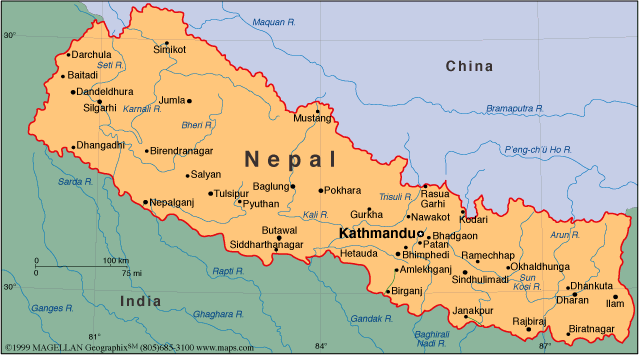
1. Introduction
Who is a neighbor? Most dictionaries give us a simple definition: "one living or located near another." However, the word also functions as a connotative expression to refer to a friend, who comes to your help, cares for you, and shares his beliefs, sorrows, happiness, etc., with you. Likewise we go to our neighbor to help him, care for him, and share with him our beliefs, sorrows, happiness, etc. Geographical adjacency is not the only or exclusive characteristic to define who a neighbor is. In a world full of prejudice, hatred, and strife, loving our neighbors with understanding and empathy for their culture and history brings a better atmosphere. Loving our neighbors as ourselves is something that all nations, particularly India, should practice, because there is a lot of misunderstanding about the goals of India as a nation in our neighborhood.
We need to develop a better understanding and appreciation of the culture and history of our neighbors. It is wrong to take things for granted or assume that Indian history and culture subsume the culture and history of all our neighbors. The Indian subcontinent is a cultural, linguistic, and religious mosaic. However, each piece of this mosaic has its own distinctive features. In addition, there are nations and nationalities in Indian neighborhood that have not been traditionally considered a part of the sub-continental mosaic. But these nationalities may share values, culture, history, religion, and social hierarchy somewhat similar to those held by the people in the Indian subcontinent.
In this article we focus on Nepal. In a subsequent article we propose to discuss Bhutan and the autonomous region of Tibet as India's neighbors. The nationalities in these territories have received mutual influence from each other as well as from India. India also has been richly blessed by the contributions it received through the ages from these nationalities.
2. A Brief Overview of the History of Nepal
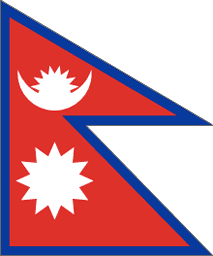
Kathmandu valley has been the home of the kingdom of Nepal for at least 1500 years. Historians divide the history of Nepal into three periods: ancient period from 500 B.C. to 700 A.D., the medieval period from 750 A.D. to 1750, and the modern period.
One of the most celebrated events in the ancient history of Nepal was the birth and ministry of Siddhartha Gautama (563-483 B.C.). The role of the king as a divinely ordained person to rule his subjects was established with the spread of the Buddhist culture and civilization. The king was seen to be the protector of the Dharma. It appears, however, that kings who were Buddhists also ruled Nepal or the kingdom in the Kathmandu valley. Nepali people, religion, and culture had received Buddhist influence from north India just as other kingdoms and dynasties were impacted by the spread of Buddhism. Emperor Asoka's conversion to Buddhism had helped the spread of Buddhism in the kingdom. The great Mauryan Empire had greatly influenced the civilization of Nepal. Gupta dynasty also had influenced the Nepali language, culture, and arts.
It is the rule of the Licchavi family (the kingdom of the Licchavis from 400-750 A.D.) that saw the emergence of a Nepali nation. The Licchavis continued to model Nepal after the trends in north India. Since Indian kingdoms and Nepal formed part of the same cultural area, the impact of the north Indian kingdoms on Licchavis was nothing strange or resisted. The kings allowed the village councils to regulate the lives of their subjects, based on caste dharma. The caste structure was not disturbed. Kathmandu valley continued to grow in importance and power. There was an amazing continuity of caste stratification for centuries among the Nepali people. It was during the Licchavi period that Buddhism spread to Tibet and Central Asia. Despite Buddhist influence Sanskrit continued to be the standard bearer for Nepali language.
During the medieval period (750-1000), however, Newari language came to be recognized as an independent language worthy of support. During this period, the Chalukya dynasty from Karnataka had some influence and power over Nepal. However, there was really no direct Chalukya contact that impacted the lives of the Nepali people. The names of some of the kings were of Chalukya origin.3. The Decline of Buddhism
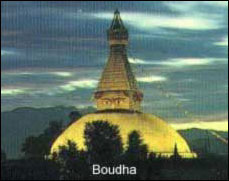
During this medieval period the influence of Buddhism over the kings was waning. Worship of and devotion to Hindu gods became very popular. Worship of Pashupatinath became the dominant religious experience.
Buddhism in Nepal also changed a lot during this period. Vajrayana Buddhism with emphasis on secret rituals became popular. The bikshus of the Buddhist orders became less influential. The Vajrayana priests or monks no more practiced celibacy. The role and function of the monasteries changed from that of a spiritual establishment to that of social and economic organizations.
In the fourteenth century the Sultanate forces from Bengal attacked Kathmandu valley, and the shrines were all demolished. In the latter half of the fourteenth century, Jayashthitimalla united the valley. Under his rule the traditional laws of Nepal were compiled. During the fifteenth century Newari became the dominant language of use for official and literary purposes. It was used in the main urban centers. Maithili was also popular in the southern parts of Nepal.
The members of the royal family as a collegium ruled Nepal with equal powers for the members during the fifteenth century. However this power-sharing arrangement did not last long. Nepal witnessed the growth of the ever-expanding Mughal Empire in India, while it was politically divided. China was also extending its control over Tibet at the same period. China even started assuming that Nepal was one of its tributary states outside China.
Just as India was divided into small and feuding princely states, Nepal also was divided into smaller states feuding among themselves for supremacy and power. The arrival of the British in India and the expansion of their power in India had its impact on Nepal also.
The modern history of Nepal since the eighteenth century saw many twists and turns, with the Qing Empire of China taking away the trade privileges of Nepal in Tibet and forcing Nepal to pay tribute to China. This did not, however, stop Nepal expanding its territory in the west and in the Kumaon and Garhwal region. The war against the British in the beginning of the nineteenth century saw Nepal signing treaty losing its territories to the British East India Company.
4. Nepal: A Land-locked Nation
Nepal is a land-locked nation. The autonomous region of Tibet surrounds it in the north. It is surrounded by India on the other three sides. Nepal has the shape of a rectangle. It is a mountainous and hilly country. However, it also has an expansive plain at the edge of the Gangetic Plain.
An interesting geographical fact is that Nepal is separated from Bangladesh by a strip of Indian land that is approximately fifteen kilometer wide. The Indian state of Sikkim with about ninety-kilometer width separates it from Bhutan. Nepal's border, thus, touches India. Tibet, and Bhutan, and it is located very close to Bangladesh.
Nepal has three geographic levels: the mountainous region in the north, the hilly region in the middle, and the Tarai ("damp, hot and humid land") plains region in the south, all running parallel to one another. The mountainous region is thinly populated, and it has the average altitude of over 4000 meters above the sea level. Mount Everest and several other beautiful peaks of the Himalayas are part of this range.
The Hill region has the altitude ranging from 1000 to 4000 meters and it lies immediately below or south of the Mountainous region. The Kathmandu valley lies in the Hill region of Nepal. This region is heavily populated and urbanized.
The Tarai Region that lies immediately or the south of the Hill region is a tropical and subtropical land. It is located between the altitudes of 300 to 1000 meters only. This region is at the end of the Gangetic Plain and shares many of its characteristics with the Gangetic Plain. In the past, the Tarai region was a kind of buffer land between the British rulers of India and the kingdom of Nepal. At present it is a highly valuable territory with agriculture and other economic activities.
5. Nepal: A Multi-Ethnic, Multi-Linguistic Nation
Nepal is a multi-ethnic and multi-linguistic nation. The Nepalese people may fall under one of the three major ethnic groups: those who occupy the Tarai region, the lower hills in the region, and the Kathmandu valley belong to the groups of people who migrated from India from the adjacent Indian provinces as well as from western India (Savada 1993).
During the Mughal rule, hundreds of years ago, many fled and migrated to Nepal to escape from the suppression of the Mughal rulers in India. These people came from the upper caste families, sometimes from the royal families of small Indian kingdoms. These occupied mid-level hill region. But they also began to move towards the Tarai region in subsequent decades. They became the land-owning class of Nepal. Today they are more powerful than any other people or caste group in Nepal. The Tarai region continued to receive migrants from adjacent Indian provinces and towns but these people were mostly landless tenants and peasants. The people of this group may be called Indo-Nepali people.
A significant Tibeto-Nepalese group occupies the mountainous region.
There are several minor social groups that may be described as indigenous people groups such as Tharu and Dhamal. This ethnic group is the smallest among the Nepalese.
6. Indo-Nepali Group
Over three-fourth of the current Nepali population (22367048 persons according to a 1999 estimate) is of the Indo-Aryan descent in their social organization, religion, language, and, to a great extent, in their physical appearance. These features have been modified with impact from other Nepalese communities, although the north Indian elements are easily seen.
This dominant Indo-Nepali group is divided into various caste categories such as the Brahmans, Kshatriyas, and other castes. Each caste category has several distinct castes. For example, the Kshatriya group has several distinct castes such as Takuri and Chhetri.
Nepali is the mother tongue of this group of people. Nepali is an Indo-Aryan language, a descendant of Sanskrit and related to Hindi. It is written with the Devanagari script.
One estimate of the linguistic composition of Nepal reports that that there are 27 distinct people groups in this category, and these groups occupy mainly the southern and eastern parts of Nepal. The largest among this category, according to Johnstone and Mandryk (2001), is the Nepali linguistic group with 12 million people, followed by Maithili 2.85 million, Bhojpuri 1.79 million, Awadhi 483000 persons, Urdu 261000 persons, Hindi 220000, and Rajbansi 110000 persons. These dialects are apparently mutually intelligible to certain extent. Since Nepali is the official language of the country, all linguistic groups acquire some competence in this language through the schooling system. Hindi or Hindustani happens to be a sort of lingua franca of the bazaar situations.
7. Tibeto-Nepali Group
The Tibeto-Nepalese group consists of communities such as Newari. The people of this group are found in the northern and western parts of Nepal. They constitute around 17 to 20 percent of the entire population. Surveys indicate that there are about 60 to 65 different people groups within this category. The languages spoken by this group are Tibeto-Burman languages.
Newari is a large mother tongue group within the Tibeto-Burman languages/dialects spoken in Nepal. According to several estimates, a little less than a million people speak Newari. Newars held very important, powerful, and influential positions in the history of Nepal. In certain ways, the Newars seek to distinguish themselves from the other Tibeto-Nepali group, especially those belonging to the Tibetan groups of people.
In Medieval Nepal (700-1759 A.D.), Newaris had political power. In many Nepali dynasties, the Newaris occupied important administrative positions. They were traders and merchants in the past. Even now they are a very important segment of the Nepali commercial class. They also occupy important political offices, and administrative positions. Nepalese art and culture are nurtured by the Newaris through the centuries. They are generally found more in the Kathmandu valley. They follow their own caste hierarchy within their society, claimed to be a parallel of the Hindu varnashrama dharma.
The Tamang is the largest Tibeto-Burman mother tongue group in Nepal. It is estimated that nearly one million and two hundred thousand people speak this language. Other important Tibeto-Burman languages are Rai (567,000), Magar (558,000), Limbu (328,000), Gurung (294,000), and Sherpa (158,000). There are nearly 150,000 refugees from Bhutan, mostly people of Nepali origin, evicted from Bhutan.
Although many Gorkha soldiers came from this group, people from the Thakuri and Chhetri segments of the Nepali population are also found in good number as Gorkha soldiers. Gorkha is not a term that refers to any particular ethnic group; it was the name of a small kingdom in Nepal that flourished in the past.
8. Greater Linguistic Cohesion and Tolerance
Although people speak the languages, dialects, or mother tongues belonging to two different language families, there is greater linguistic cohesion among the peoples of Nepal than we notice in India. Nepalese people view themselves as belonging to a distinct nation of Nepal. There is unity in the midst of linguistic, religious, and cultural diversity.9. Mother Tongues According to the 1981 Census of Nepal
The following table gives the distribution of population by mother tongue, according to the 1981 Census of Nepal. (Taken from Savada 1993.)
| Mother Tongue | Number | Percentage |
| Nepali | 8,767,361 | 58.4 |
| Maithili | 1,668,309 | 11.1 |
| Bhojpuri | 1,142,805 | 7.6 |
| Tharu | 545,685 | 3.6 |
| Tamang | 522,416 | 3.5 |
| Newari | 448,746 | 3.0 |
| Abadhi | 234,343 | 1.5 |
| Rai and Kirati | 221,353 | 1.5 |
| Magar | 212,681 | 1.4 |
| Gurung | 174,464 | 1.2 |
| Limbu | 129,234 | 0.9 |
| Bhote (or Bhotia) and Sherpa | 73,589 | 0.5 |
| Rajbansi | 59,383 | 0.4 |
| Satar | 22,403 | 0.1 |
| Danuwar | 13,522 | 0.1 |
| Sunwar | 10,650 | 0.1 |
| Santhal | 5,804 | - |
| Thakali | 5289 | - |
| Other | 764,802 | 5.1 |
| TOTAL | 15,22,839 | 100.0 |
Note that, when the three major Indo-Aryan languages, Nepali, Maithili, and Bhojpuri are included under one group, more than seventy-five percent of the Nepalese speak a form of language somewhat related and mutually intelligible to a great extent.
10. Castes in Nepal
Some estimates of caste populations are also available. The Chhetri is the largest caste group with 3.8 million people, followed by the Hill Brahman caste group with 3.1 million, Magar with 1.7 million, Maki/Lohar with 1.2 million, Yadav/Ahir with 1 million people, and Chamar around 300,000 people.
The Tibeto-Burman or Tibeto-Nepali groups of people are not conscious of a caste hierarchy among them. The local Hindus may assign them some place in the Hindu caste hierarchy, however. When they place themselves in relation to the Hindu hierarchy, the Tibeto-Nepali people often view them to superior in rank to those of the Hindu castes or Newars surrounding them. Caste ranking as in India is a dynamic feature among various castes in Nepal. The status of a caste may vary from place to place depending upon their economic and political power.
Nepalese society may be seen as consisting three groups: ruling class or elite group, a group of government officials, landholders, and merchants; and the group of peasants who form the largest constituent of the Nepalese society. The ruling class comes from the royal family, and the upper or higher caste Brahmans and Kshatriyas (Chhetris).
It appears that caste did play an important role even in the thinking of the Buddhists, especially among the Indian Buddhists. Gautama Buddha, in several expositions, did not approve of the high status accorded to the Brahman caste in Hinduism. Yet, the role played by the Brahmans in the Hindu religious community was recognized and appreciated even by the Buddhists. For example, Nagarjuna (A.D. 100), a great Buddhist intellectual and spiritual leader, wrote about the life-history of a Bodhisattva in this way: "The question now arises from what date onward he (a man who is on his journey to become a Bodhisattva, -- the authors of this paper) a 'Bodhiisattva'. This change from an ordinary being to a Bodhi-being takes place when his mind reached the stage when it can be no longer turn back on enlightenment. Also, he has by then gained five advantages: he is no more reborn in the States of woe, but always among gods and men; he is never again born in poor or low-class families; he is always a male, and never a woman; he is always well-built, and free from physical defects; he can remember his past lives, and no more forgets them again" (Conze 1959:30-31).
The social hierarchy that one notices among the Indo-Nepalese groups is not wholly seen in the other groups of Nepalese people. Buddhism had a re-birth in Nepal when people of Tibeto-Burman affinity became Buddhist through the impact of Tibetan Buddhism. This perhaps explains the non-adoption of Indian Hindu caste hierarchy among these people groups. Variables other than caste came to identify social stratification among these people groups.
11. Religion
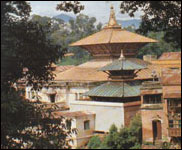
Hinduism is declared as the official religion of the country. Some estimates put the percentage of Hindus in Nepal around 89 per cent, whereas others put it around 79 per cent. Likewise, some estimates put the percentage of Buddhists in the country around nine or ten percent, while others put the estimate around 16 per cent.
There is a great and interesting admixture of Hinduism and Buddhism in Nepal. This admixture has existed for centuries. It is only natural that in the region or nation where Siddhartha was raised and where his thought had great impact through royal patronage and Buddhist missionary efforts, people tend to see Hinduism and Buddhism as a way of life not inimical to each other.
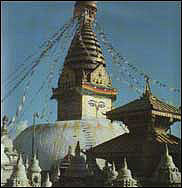
Hindus worship in Buddhist temples and Buddhists worship in Hindu temples. Hinduism is the popular religion of the people groups affiliated to the Indo-Nepalese spectrum. Buddhism is the popular religion among the Tibeto-Nepalese spectrum. Hindus are found as the majority in every region, whereas the Buddhists are found in large numbers in the hill and mountainous regions and in Kathmandu valley. Several communities within the Tibeto-Nepalese spectrum such as the people belonging to Magar, Sunwar, and Rai people groups are more Hinduized than others. People belonging to the Gurung, Limbu, Bhote and other Tibeto-Nepalese groups have received least Hindu influence. Both Mahayana Buddhism and Vajrayana Buddhism are followed.
Ashvaghosha, a great Indian poet who lived in the first century A.D., wrote an interesting work called Buddhacaritra, in which he describes the birth of Sidhhartha in miraculous terms: "There lived once upon a time a king of the Shakyas, a scion of the solar race, whose name was Shuddhodana. He was pure in conduct, and beloved of the Shakyas like the autmn-moon. He had a wife, splendid, beautiful, and steadfast, who was called the Great Maya the Goddess. ... He (Siddhartha) came out of his mother's side, without causing her pain or injury. His birth was as miraculous as that of Aurva, Prithu, Mandhatri, and Kakshivat, heroes of old who were born respectively from the thigh, from the hand, the head or the armpit" (Conze 1959:35).
Ashvaghosha writes the history of Siddhartha's conversion and ultimate partinirvana with great passion and devotion, in a style that has moved the hearts of the Buddhists for centuries. The scenes involve ancient Nepal, Varanasi, and Bihar. There are references to an ancient Malla dynasty that ruled parts of present-day India and Nepal. There is perhaps some diplomatic lesson to learn from the story of Gautama's cremation. This is what Ashvaghosha writes: "Soon it had burnt up the Sage's skin, flesh, hair and limbs. But although there was plenty of of ghee, fuel, and wind, it could not consume His bones. These were in due time purified with the finest water, and placed in golden pitchers in the city of Mallas. And the Mallas chanted hymns of praise over them ... For some days they worshipped the relics in due form and with the utmost devotion. Then, however, one by one, ambassadors from the seven neighbouring kings arrived in the twon asking for a share of the relics. But the Mallas, a proud people and also motivated by their esteem for the relics, refused to surrender any of them. Instead, they were willing to fight. The seven kings, like the seven winds, then came up with great violence against Kusinagara, and their forces were like the current of the flooded Ganges. Wiser counsels prevailed, and the Mallas devotedly divided into eight parts the relics of Him who had understood Life. One part they kept for themselves. The other seven others were handed over to the seven kings, one to each. And these rulers, thus honoured by the Mallas, returned to their own kingdoms, joyful at having achieved their purpose ..." (Conze 1959:65).
We will discuss the role of Buddhism in adjacent Bhutan and Tibet in our next article.
12. Importance of Nepal
The past history of Nepal clearly reveals that it has been a dynamic and independent country. The Nepalese history as well as the migration patterns of the Nepalese peoples reveals that they are an enterprising nation. They were also bold and adventurous. They also recognize the limitations imposed on them by the overpowering presence of two large Asian nations, India and China. While their ethnic, linguistic, and religious composition as well as their social organization, structure, and stratification brings them closer to India, especially now with better roads and other communication channels, they are very conscious about the steps they should take and pursue to maintain the independence of their nation. Moreover, there is a substantial Nepali speaking population native to India in all the major cities and towns of India, the states of West Bengal and Sikkim, and in Bhutan. Nepal can always use the good offices and influence of this international segment to their advantage. Nepal is strategically placed even in its geographic location.
There is a greater appreciation of these factors in the higher levels of political leadership and the civil services in India. However, the same is not the case with the lower level functionaries and with the common men and women in India. Even with our limited experience in these matters, we always sensed a condescending and patronizing tone in the verbal and nonverbal communication behaviors of the last mentioned categories whenever they referred to or talked to the Nepalese people. India needs to educate her citizens better in this area. A sense of admiration and love should flow in our textbooks when we teach about Nepal, not an attitude that looks down upon the hills people. For ages the ruling classes and the elites in India have displayed this attitude towards the so-called "Junglees," and this continues even today. This attitude has been passed down to the other classes also in India.
Some Indian leaders have been advocating political intervention in the politics of Nepal in order to establish or restore "democracy." Any interference is bound to backfire, and will not be in the interest of India. Since the polity of Nepal is a continuum of South Asian polity, the people of Nepal will be able to solve their problems on their own without interference from others.
Right now it is not clear whether the linguistic groups such as Maithili, Bhojpuri, Newari, and Tamang would continue to clamor for the recognition of their mother tongues as languages of political power or not. The spread of Hindi or Hindustani as an important language of communication outside government offices will continue. Ultimately, Hindi as a closely related language of the dominant linguistic groups in Nepal will achieve a status second only to Nepali.
The problems faced by Nepali as the dominant medium of instruction are similar to those faced by the major Indian languages. Language textbooks need to be re-designed to meet the needs of Nepali as the official language. Developing a conceptual prose that facilitates the teaching and learning of science subjects is one of the urgent needs of Nepali.
REFERERNCES
Conze, Edward. (Editor and translator). 1959. Buddhist Scriptures. Baltimore: Penguin Books.
Johnstone, Patrick, and Mandryk, Jason. 2002. Operation World. Minneapolis, MN: Bethany House Publishers.
Savada, Andrea Matles. (Ed.). 1993. Nepal and Bhutan: Country Studies. Washington, D.C.: Federal Research Division, Library of Congress.
HOME PAGE | BACK ISSUES | Vocabulary Education | Multilingualism and Multiculturalism Issues
Pertinent to Speech and Language Pathology | Learning Indian Languages - A
French View | Language, Religion, and Society in Indian Neighborhood: Nepal | Syntax and Semantics of Verbs of Transfer in Tamil | CONTACT EDITOR
B. Mallikarjun, Ph.D.
Central Institute of Indian Languages
Mysore 570006, India E-mail: mallikarjun@ciil.stpmy.soft.net